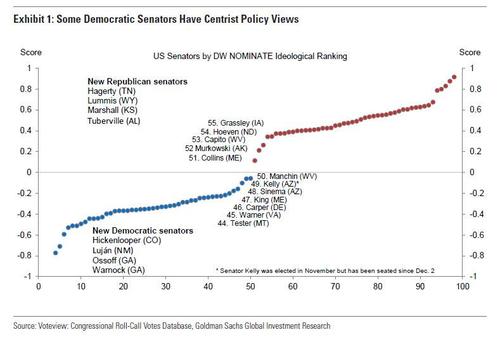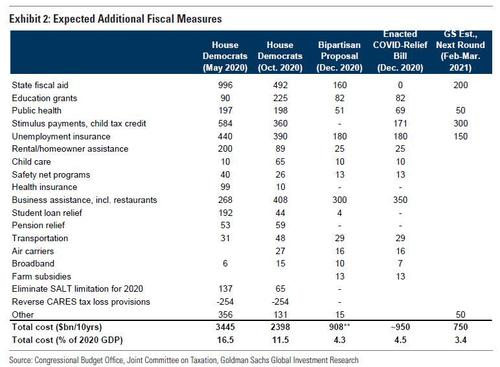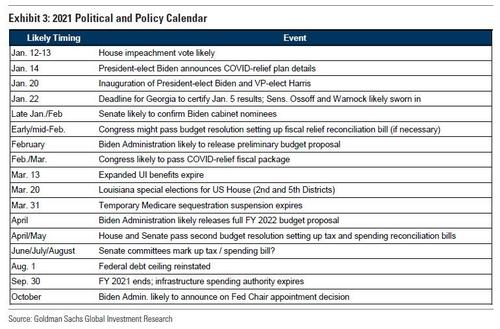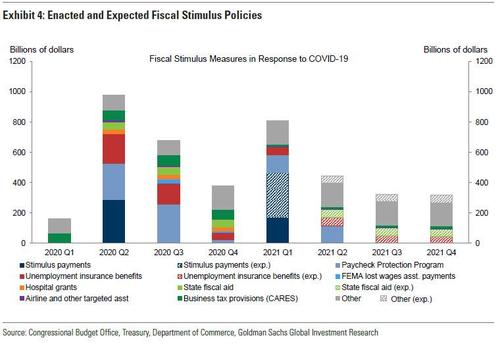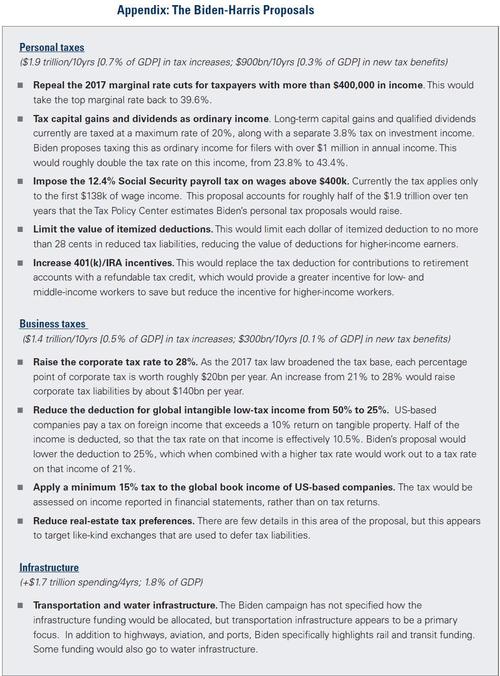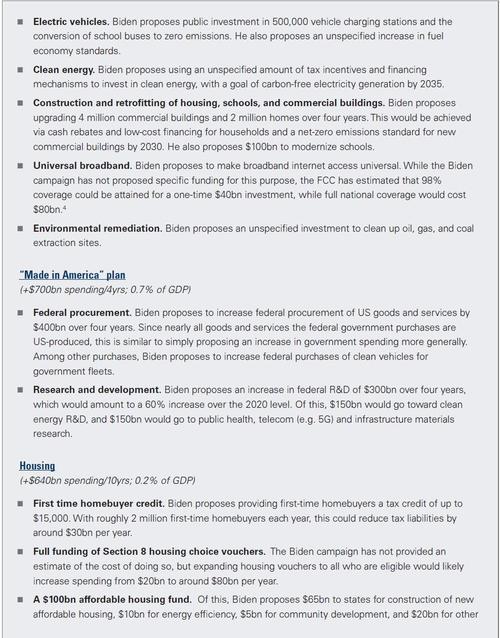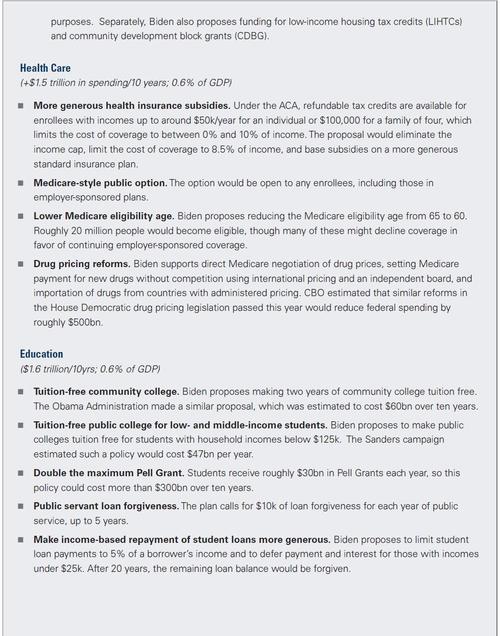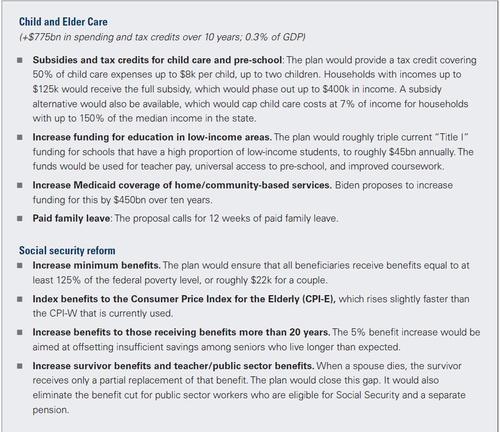Fra Zerohedge/ Goldman:
Following the runoff elections in Georgia, Democrats now have 50 seats in the Senate and therefore will set the US political agenda in both chambers. This changes the policy outlook substantially, as it means that President-elect Biden can pass fiscal legislation without Republican support as long as Democrats remain unified. Nevertheless, the incoming administration will face political constraints in such closely divided House and Senate, and practical constraints imposed by congressional procedures.
Below we list some of the most frequently questions Goldman clients have about what life will look like under Democrat control for at least the next two years.
How will President-elect Biden and congressional Democrats govern?
Goldman expects a bipartisan approach, at least at the outset. The most important question regarding the policy outlook over the next year will be how President Biden—along with House Speaker Pelosi and soon-to-be Senate Majority Leader Schumer—balance the political and practical benefits of bipartisan support with the policy benefits of passing legislation even over Republican opposition. Recent events in Washington might increase Democratic interest in finding bipartisan support while also increasing Republican willingness to support aspects of the Biden Administration’s agenda, at least in the near term.
Why wouldn’t Democrats use the budget reconciliation process to do as much as possible from the start?
While the reconciliation process has one major advantage—it allows the majority party to pass legislation without support from the minority—it has several disadvantages.
First, with a 50-50 split in the Senate and a very narrow margin in the House, Democratic leaders would need virtually unanimous support from Democrats in both chambers to pass any legislation. As shown in chart below, the policy positions of the most centrist Senate Democrats are farther from some other Democrats than they are from some Republicans. This is likely to constrain what Democrats might accomplish via reconciliation.
Second, there are limits to what a reconciliation bill may include. The Senate’s “Byrd Rule” prohibits reconciliation bills from including provisions that do not change spending or revenues, or policies whose budgetary effects are “merely incidental” to the non-budgetary components. The rule also prohibits a net increase in the deficit after the period covered by the budget resolution (normally 10 years) and changes to Social Security. This essentially prohibits use of the process to make regulatory changes and makes it difficult to establish new programs, as the “authorization” for a program does not in itself change spending or revenues. Congress has never before used the reconciliation process to appropriate funds, although it is not explicitly prohibited in the Budget Act. As discussed later, this could complicate certain aspects of COVID-relief legislation as well as parts of the Biden infrastructure proposal.
In light of these issues, Goldman believes there is a good chance that Democratic leaders will initially attempt to pass fiscal relief legislation through regular order in the Senate, though they may fall back on the reconciliation process if they cannot find sufficient bipartisan support.
What does this mean for the size of fiscal stimulus?
As noted last week, Goldman now expects another package of near-term fiscal relief measures worth around $750bn (3.4% of GDP). There is a fairly good chance of sufficient bipartisan support for a package that addresses four main areas. First, GS expects around $200bn in state and local fiscal aid. Second, there could be a further extension of expanded unemployment benefits past the March 14 expiration, likely involving a gradual phase down through year-end of the current $300/week extra benefit, possibly tied to the unemployment rate. Third, additional funding for testing and vaccine distribution. Fourth, Congress will likely approve another round of payments to individuals of $1400/person (for a total of $2000/person when counting the $600/person payments Congress approved in late 2020). Spending in other areas is also likely, potentially including further support for small business. Goldman’s summary expectations for additional fiscal measures are shown in Exhibit 2.
If adequate Republican support does not materialize, Goldman expects Democrats to use the budget reconciliation process to pass a COVID-relief bill. In that scenario, certain aspects of their prior proposals might need to change. For example, Democrats previously proposed to provide fiscal aid by appropriating lump sums to state governments, but reconciliation bills are not used to appropriate funds. A potential workaround would be to increase matching payments to states in the Medicaid program, which reconciliation rules would clearly allow but which might slow the flow of dollars to the states. Similar issues might exist for spending on vaccine distribution or testing, though it is doubtful many senators would challenge spending in those areas.
In either scenario, the overall size of the package will be limited by the marginal senator supporting it. Goldman assumes that the senator casting the 50th vote—likely a Democrat—would support a higher-priced bill than the senator casting the 60th vote, who would almost certainly be a Republican. Use of the reconciliation process might therefore allow Democrats to pass a somewhat larger fiscal relief package. That said, the recent skepticism from Sen. Joe Manchin (D-W. Va.) regarding additional stimulus payments, which at least a few Republican senators have supported, suggests that the difference might not be that great. Overall, the bank expects a package of around $750bn (3.4% of GDP), though the risks to this figure skew toward a larger package.
When will Congress pass the next round of fiscal measures?
Congress will enact fiscal relief legislation between mid-February and mid-March. In light of the constraints that COVID-relief legislation is likely to face, the next round of fiscal measures is unlikely to pass until mid-February at the earliest. If Democratic leaders take a bipartisan approach, the bill is likely to pass whenever they are confident it will win at least 60 votes in the Senate.
If they use the reconciliation process instead, it could take longer to pass, as it would involve two steps. The first step would be the formulation and passage of the fiscal year 2021 budget resolution, which would need to include a “reconciliation instruction” to the relevant committees, including how much the bill should increase the deficit. At this stage, there would be no binding policy decisions, though one would expect that the White House and/or congressional Democrats would separately release a proposal detailing the policies assumed. This process would likely take until at least mid-February. In a second step, Congress would then need to pass the actual “reconciliation” legislation. This would likely take at least a few more weeks from the time Congress agrees to the budget resolution.
When would fiscal stimulus reach the economy?
An additional round of payments could reach individuals in 1-2 weeks after enactment, but other aspects might take longer. The Treasury might make another round of stimulus payments one to two weeks after President-elect Biden signs the legislation. On January 4, the Treasury paid out around half of the stimulus payments authorized under the most recent legislation, which Congress passed on Dec. 21 and which became law on Dec. 28. Other parts of the bill would likely take longer to have an effect on spending. Goldman expects Congress to extend expanded unemployment benefits, which expire March 14, but the roughly $150bn estimated cost would be spread over the remainder of 2021.
The timing for payment of state fiscal aid would depend on the form it takes. If Congress appropriates funds the way it has in prior COVID-relief legislation, the Treasury would make large lump-sum payments within a few weeks. Conversely, if the legislation passes via reconciliation, it is possible the payments could take a different form—increased Medicaid payments to states, for example—which could spread those transfers over several quarters.
Will personal taxes rise?
Upper-income tax rates probably will increase to finance other personal tax reductions. Unlike COVID-relief legislation, which some Republicans might support, there will be little Republican support for tax increases, which makes it very likely that Democrats use the reconciliation process to raise taxes. The Byrd rule prohibits changes to Social Security taxes via reconciliation, so President-elect Biden’s proposal to apply the 12.4% Social Security payroll tax to income over $400,000 is unlikely to pass this way. However, there are no procedural obstacles to raising other taxes via reconciliation.
Congress will likely reverse some of the individual income tax changes that Congress passed in 2017, but a net increase in personal taxes is not expected. Specifically, Goldman believes the top marginal rate to go back to 39.6% from 37% and limitations on itemized deductions to return. However, since the changes the 2017 tax law made in both of those areas expire after 2025, this would only raise around $160bn over ten years, according to estimates from the Tax Policy Center. President-elect Biden also proposed, as the Obama Administration had, to limit the tax benefit from itemized deductions to their value at a 28% tax rate. TPC estimates this would raise around $225bn over ten years. More importantly, it would generate a permanent increase in revenues that could be used to offset other permanent spending increases or tax cuts.
A partial restoration of the deduction of state and local income and property taxes looks likely. The 2017 tax law limited this deduction to $10,000, and returning to the prior policy is a top priority for congressional Democratic leaders even though it was not formally part of the Biden campaign tax proposal. However, restoring this deduction is expensive and regressive, which is likely to lead some progressive Democrats to oppose the change. A few Democratic senators whose states have low or no income taxes might also balk at raising personal taxes to restore that deduction.
Will capital gains taxes increase?
Capital gains taxes are unlikely to rise as much as President-elect Biden proposed. During the presidential election campaign, President-elect Biden proposed to tax long-term capital gains and qualified dividends at the rate on ordinary income (39.6% under his proposal) for individuals with incomes over $1 million. This looks unlikely, as at least a few Democratic members of the House and Senate are likely to object. It is harder to rule out any tax increase on capital gains and dividends, however. If Congress does raise the rate on capital gains and dividends, a rate around 28%—the same rate President Reagan and a divided Congress agreed to in the Tax Reform Act of 1986—seems to us to be about the highest it might go.
Will corporate taxes rise?
Goldman expects the corporate tax rate to increase to no more than 25%. President-elect Biden proposed to raise the corporate tax rate from 21% to 28%, increase the effective tax rate on international intangible income, and to impose a global minimum tax on corporations, among other changes. There will likely not be sufficient support among congressional Democrats to implement all of these proposals but there will be enough support among centrist Democrats to raise the corporate tax rate to around 25% and to incrementally increase taxation of international corporate income earned by US-based companies. Each percentage point increase in the corporate income tax rate would generate around $100bn in additional revenue over the next 10 years, so an increase to 25% would generate around $400bn over that period; other corporate tax changes might raise this total somewhat further. Corporate taxes are set to rise after 2021 in any case, when restrictions on interest deductibility and expensing of R&D become more restrictive; full expensing of equipment investment also begins to phase out after 2022. It is unlikely that Congress will extend any of those policies without raising the corporate rate, so a tax increase in corporate taxes seems likely one way or the other.
Will tax increases be retroactive?
No, Goldman expects tax increases to take effect in 2022, and does not believe taxes will be increased retroactively to the beginning of 2021. Congress is also not expected to pass tax legislation until mid-year. Making a tax increase retroactive at that point would make them more controversial at a time when thin House and Senate majorities will make it difficult to raise taxes at all. In light of the ongoing recovery and little concern among policymakers regarding deficits, the political cost of a retroactive tax increase would probably outweigh the benefits.
What would new tax revenue be spent on?
Congress is likely to spend all the new revenue, and possibly more, on infrastructure and social benefit programs. During the presidential campaign, the President-elect proposed more than $5 trillion over 10 years in new spending, with much of it front-loaded into the first few years. The proposals covered infrastructure and climate policies, domestic manufacturing and R&D, health care benefits, education, and child care, among other things (see the appendix for details). It is not yet clear which of these policies will take priority, but infrastructure and climate-oriented policies appear to be high on the list. A limited appetite in Congress for tax increases could constrain how much of this agenda President-elect Biden can enact.
Will Republicans support an infrastructure program?
Infrastructure looks like the most likely aspect of the Biden agenda to win Republican support, and is also one of the areas where some bipartisan support might be necessary. In light of the constraints the reconciliation process imposes, some aspects of President-elect Biden’s infrastructure proposal—particularly direct government spending on traditional heavy infrastructure areas like highways, transit, airport, water, and sewer projects—are more likely to be addressed through regular order, requiring 60 votes. Republicans are likely to support an increase in spending but are likely to be a constraint on the overall increase in spending in these areas. Goldman expects that Congress will address at least some of these policies when it reauthorizes the surface transportation program, which expires Sep. 30, 2021.
By contrast, congressional Democrats might use tax policy to address other infrastructure and climate-related issues. Doing so would allow them to pass these initiatives through the reconciliation process, circumventing any Republican opposition. The challenge in doing so is that tax incentives are primarily effective in stimulating activity organized by the private sector, while much of the Biden plan, at least during the campaign, appears focused on public-sector activity. While some tax incentives help public-sector investment—tax benefits for municipal bonds lower borrowing costs—the benefits are more limited, particularly when interest rates are already low. Nevertheless, tax incentives could be particularly useful in lowering the cost of building out a 5G network, increasing the number of electric vehicle charging stations, upgrading rail networks, expanding solar and wind generation capacity, and increasing efficiency in commercial and residential property.
What about health care?
Although infrastructure is in the spotlight, health benefits will be a focus of legislative efforts this year. President-elect Biden proposed to broaden eligibility for the health insurance premium subsidies under the Affordable Care Act (ACA) and to make them more generous. He also proposed to lower Medicare eligibility to age 60. Versions of all of these proposals have a good chance of enactment through the reconciliation process, but financing them could be difficult in light of the limited appetite for tax increases and the competing claims on the revenues they would produce.
Biden also proposes to restrict prescription drug pricing through various means and to make available a Medicare-like “public option” through the marketplaces that the ACA established. While aspects of these policies might become law, they will likely face greater opposition and greater obstacles, as some aspects of those proposals might not be eligible for inclusion in budget reconciliation legislation, but are unlikely to attract much Republican support.
How much of a risk is the debt limit this year?
Goldman expects raising the debt limit to be a fairly minor issue this year. The two-year suspension of the debt limit expires July 31. Once reinstated, Congress will have several weeks to raise it or, more likely, pass a new suspension. Along with taxes and some spending, the debt limit is eligible for inclusion in reconciliation legislation. If congressional Democrats opt to pass COVID-relief legislation using that process, they could extend the debt limit suspension and resolve the issue long before the current suspension expires. If not, the debt limit is more likely to be reinstated, leaving congressional Democrats to pass an increase in August or September.
What does Democratic control of the Senate mean for regulation?
It is unlikely to lead to substantially different legislative outcomes than would have occurred under Republican control, but it will influence regulation indirectly. Regulatory, legal, and other non-budgetary changes cannot generally pass via the reconciliation process, so any regulatory-focused legislation would still need bipartisan support. However, Democratic control of the Senate will allow President-elect Biden to nominate officials who favor more stringent regulation than Republicans support. However, this will depend on the issue and there are some issues, like environmental regulation, where the position of the marginal Democratic vote in the Senate might not be very different from the position of the marginal Republican. Democrats could also overturn regulations that the Trump Administration implemented since August 2020 with a simple majority in the Senate, under the Congressional Review Act (CRA).


